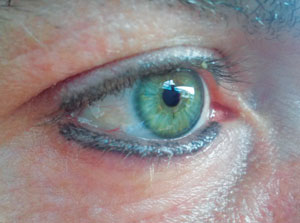A new study found patients with eyelid tattoos had shortened tear break-up time (TBUT) and induced meibomian gland loss, suggesting eyelid tattoos could be another risk factor for ocular surface disease.
 | |
| Eyelid tattooing is becoming an increasingly popular aesthetic procedure. Photo: Sara Weidmayer, OD. |
Researchers from the Hallym University College of Medicine in Seoul, Republic of Korea, and the Seoul National University Bundang Hospital in Seongnam, Republic of Korea, looked at 10 women with eyelid tattoos and 30 women without as controls. They studied TBUT, corneal erosion and meibomian gland loss in relation to a tattoo score given to each subject based on the distance between the tattoo and the eyelid margin. They found the TBUT in the tattoo group was shorter than that in the control group, and the TBUT significantly correlated with the total tattoo score.
Fluorescein staining showed that corneal erosion was more severe in the tattoo group than in the control group, and meibography revealed meibomian gland loss was more severe in the tattoo group than in the control group.
“This study may have some clinical implications for a small subset of our patients who inquire about, or have had, the procedure, certainly regarding more robust patient education, but also regarding more vigilant dry eye/MGD treatment in those with eyelid tattoos,” says Sara Weidmayer, OD.
However, Dr. Weidmayer notes the study was small and was more observational rather than clearly defined as a prospective cohort study. Also, “in a 40- to 50-year-old female cohort, many likely had pre-existing dry eye or MGD and the mean follow up was relatively short,” she says. Dr. Weidmayer recommends optometrists remain aware of new research, but remember, “pathologic meibomian gland changes observed over time after eyelid tattooing should be further investigated before firm conclusions are drawn from this single small study.”
Lee YB, Kim JJ, Hyon JY, et al. Eyelid tattooing induces meibomian gland loss and tear film instability. Cornea. 2015 Jul;34(7):750-5.
